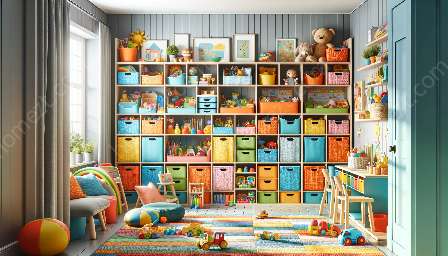Children's toys can quickly clutter small living spaces, creating chaos and disorganization. Effective toy storage solutions not only ensure a tidy home but also promote toy organization and efficient use of space. In this guide, we'll explore innovative ways to store toys in small spaces, covering strategies that align with toy organization principles and the use of home storage and shelving systems.
Challenges of Toy Storage in Small Spaces
Living in a small home or apartment presents unique challenges when it comes to storing toys. Limited square footage demands creative solutions to keep toys organized, easily accessible, and out of the way when not in use. Moreover, parents often seek toy storage options that blend seamlessly with their existing home storage and shelving units while maintaining a cohesive design aesthetic.
Integrating Toy Organization Principles
Toy organization relies on the principles of categorization, accessibility, and visual appeal. In a small space, it's crucial to categorize toys and allocate specific storage areas for each category. This not only facilitates easy access for children but also teaches them the importance of organization. Additionally, incorporating elements of visual appeal into toy storage can transform the organizational process into an engaging and aesthetically pleasing activity for both children and parents.
1. Multi-functional Furniture
One innovative approach to toy storage in small spaces is the use of multi-functional furniture. Pieces like ottomans with built-in storage compartments, storage benches, and coffee tables with hidden storage can seamlessly blend into the living space while providing ample room for toy organization. These versatile furniture items serve a dual purpose, offering both storage solutions and practical usage as seating or display surfaces.
2. Wall-Mounted Toy Storage
Maximizing vertical space is essential in small living environments. Installing wall-mounted shelving units designed specifically for toy storage can effectively free up floor space while creating an organized display. Modular and customizable systems allow for easy adjustments to accommodate different types of toys and adapt to the changing needs of a growing child.
3. Stackable Storage Bins and Baskets
Stackable storage bins and baskets are indispensable tools for toy organization. These containers can be neatly stacked in a corner or under a bed, utilizing often overlooked spaces. Opting for clear or labeled bins makes it easy for children to identify and access their toys while simultaneously promoting the habit of tidying up after playtime.
Blending Toy Storage with Home Storage & Shelving
When considering solutions for toy storage in small spaces, it's important to ensure that they seamlessly integrate with existing home storage and shelving units. This integration not only contributes to a cohesive design but also maximizes the utility of the available space. Customizable shelving systems, modular cabinets, and versatile organizers allow for a harmonious blend of toy storage and general home organization.
4. Customizable Shelving Systems
Investing in customizable shelving systems offers the flexibility to adapt storage configurations to suit varying toy sizes and quantities. Adjustable shelves and removable dividers provide a personalized approach to toy organization while allowing for the inclusion of decorative and functional elements to enhance the overall aesthetic of the space.
5. Under-Stair Storage Units
In homes with staircases, the space underneath can be transformed into an accessible toy storage area. Custom-built under-stair storage units or pre-fabricated storage solutions can effectively utilize this underutilized area, providing a dedicated space for toy organization without encroaching on the main living areas.
6. Toy Storage Cubbies
Integrating standalone or modular toy storage cubbies into existing shelving units offers a streamlined approach to toy organization. These cubbies can be configured to accommodate various toy categories and provide a clear separation, making it easy for children to find and return their belongings. Customizing the cubbies with colorful bins, labels, or personalized decorations further enhances the interactive and engaging nature of toy storage.
Conclusion
Efficient toy storage in small spaces is not only about maintaining a clutter-free environment but also about instilling organizational skills in children while creating a harmonious living space. By considering the principles of toy organization and seamlessly blending toy storage solutions with home storage and shelving units, parents can create an organized, functional, and visually appealing environment that fosters creativity, independence, and a sense of ownership in children.


